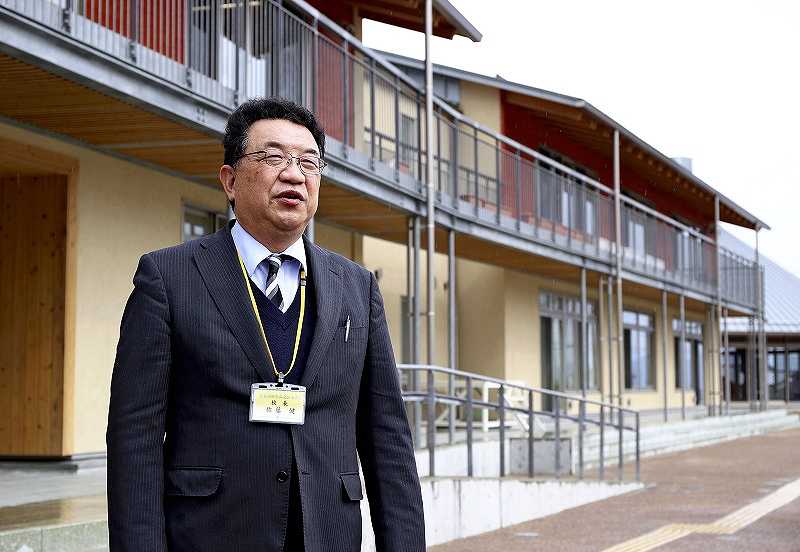
Ken Sato, principal of Kesen Elementary School in Rikuzentakata, Iwate Prefecture, stands in front of the school building on March 3.
10:57 JST, March 12, 2022
RIKUZEN-TAKATA, Iwate — “For those of us who live in Kesen, March 11 is a day we must never forget,” school principal Ken Sato said to his students on March 8.
Sato was addressing all 54 pupils at Kesen Elementary School in Rikuzen-Takata, Iwate Prefecture, who were listening online due to the coronavirus pandemic. Although the Great East Japan Earthquake of 2011 happened within the lifetime of today’s fifth- and sixth-grade students, they have almost no memory of it.
When the quake hit, all students at the elementary school evacuated safely, but the school building was destroyed. For a time, classes were held in a different elementary school, but such events are gradually fading into the past.
Sato, 56, tried to use easy-to-understand language to convey his message, saying: “We should be rightly afraid of disasters. This will help us protect our own lives and those of our loved ones.”
There are some children Sato will never forget: Eight boys who died in the disaster were students at the junior high school where he was teaching at the time.
Sato taught social studies at Otomo Junior High School in the city. The school had 60 students and was located a little outside the town. All of the boys who died were on the baseball team.
On March 11, many students had returned home in the morning as the school’s graduation ceremony was the following day. However, 12 students remained at the school to help the teachers and other staffers put up decorations for the event.

The downtown area of Rikuzentakata is seen on March 13, 2011, after being devastated by the tsunami.
After the earthquake hit at 2:46 p.m., Sato and the others hastily climbed up a hill behind the school. Black water soon engulfed the fields below, rising as high as the second floor of the school. Faced with the fury of a tsunami for the first time, the students broke down in tears.
The next morning, Sato and some other teachers started checking on the children who had returned home. Phones were out of order and the streets were choked with debris. Unable to drive, they walked the muddy streets to visit evacuation centers.
One student’s home had been swept away, but to their relief they found the student trying to stay warm next to a fire. However, six first-year and two second-year students were never found.
A sign one of the parents had posted outside their house, saying, “Have you seen this child?” was almost more than Sato could bear.
Eventually, it was learned that the eight boys had gone into town to buy presents for students who were graduating. After the quake, the boys went to the civic gymnasium, which was the designated evacuation center. However, this building was not located on high ground and 80 to 100 people inside lost their lives to the tsunami.
Following the quake, Sato often asked himself, “Weren’t those the lives that could have been saved?”
Three years later, Sato became vice principal at Kamaishi-Higashi Junior High School in Kamaishi.
Kamaishi, too, was ravaged by the tsunami, but almost none of the city’s roughly 3,000 elementary and junior high school students died. This fact is often referred to as the “miracle of Kamaishi.” Students at Kamaishi-Higashi were praised because they fled to higher ground from their initial evacuation center.
As someone who had lost students, Sato felt a sense of shame when sending out information from the school where the “miracle” occurred. When making the rounds for practical training, he sometimes heard people praising the actions of the Higashi students, and it felt almost painful.
Sato decided he needed to face up to his feelings. He spoke with colleagues, went back to study disaster preparedness education and became a certified disaster relief specialist. He discovered that the “Tsunami Tendenko” philosophy of prioritizing one’s own safety — the thing that is said to have made the miracle happen — is not the be-all and end-all.
He learned that creative teaching methods, such as using a car to demonstrate the speed of a tsunami or introducing unexpected elements into evacuation drills, were what saved the lives of children from a disaster bigger than anyone could have imagined.
Sato treasures a photo taken four years ago at a party following the coming-of-age ceremony for those who were first-year students at Otomo Junior High School when the quake hit. The photo shows smiling young people dressed in suits and kimono. Every time he looks at it, Sato thinks of the futures taken from the eight boys who are not in the photo.
Even though he is a principal now, Sato still teaches disaster preparedness in the classroom. “I teach the children with me now so our losses that day won’t be in vain,” he said. “That’s my duty, I believe.”
Inconsistent education
Education, Culture, Sports, Science and Technology Ministry statistics as of September 2012 showed that 495 students and teachers from elementary, junior high and high schools died in the Great East Japan Earthquake.
Official teaching guidelines were revised after the earthquake, increasing and improving disaster-related education in such areas as disaster preparedness, natural disasters and safety. However, this education is delivered across a variety of subjects and in various ways.
Seiji Suwa, chairman of the Japanese Society for Disaster Education, pointed out that “disaster education is left up to [teachers] on the ground, and there are variations in quantity and quality.” Suwa has called for disaster education to be made a separate subject and for teachers’ training to be expanded.
"Society" POPULAR ARTICLE
-

M4.9 Earthquake Hits Tokyo, Neighboring Prefectures
-

M7.5 Earthquake Hits Northern Japan; Tsunami Waves Observed in Hokkaido, Aomori and Iwate Prefectures
-

Tsukiji Market Urges Tourists to Avoid Visiting in Year-End
-

Israeli Tourists Refused Accommodation at Hotel in Japan’s Nagano Pref., Prompting Protest by Israeli Embassy and Probe by Prefecture
-

M5.7 Earthquake Hits Japan’s Kumamoto Pref., Measuring Upper 5 Intensity, No Tsunami Expected
JN ACCESS RANKING
-

Keidanren Chairman Yoshinobu Tsutsui Visits Kashiwazaki-Kariwa Nuclear Power Plant; Inspects New Emergency Safety System
-

Imports of Rare Earths from China Facing Delays, May Be Caused by Deterioration of Japan-China Relations
-

University of Tokyo Professor Discusses Japanese Economic Security in Interview Ahead of Forum
-

Japan Pulls out of Vietnam Nuclear Project, Complicating Hanoi’s Power Plans
-

Govt Aims to Expand NISA Program Lineup, Abolish Age Restriction






















